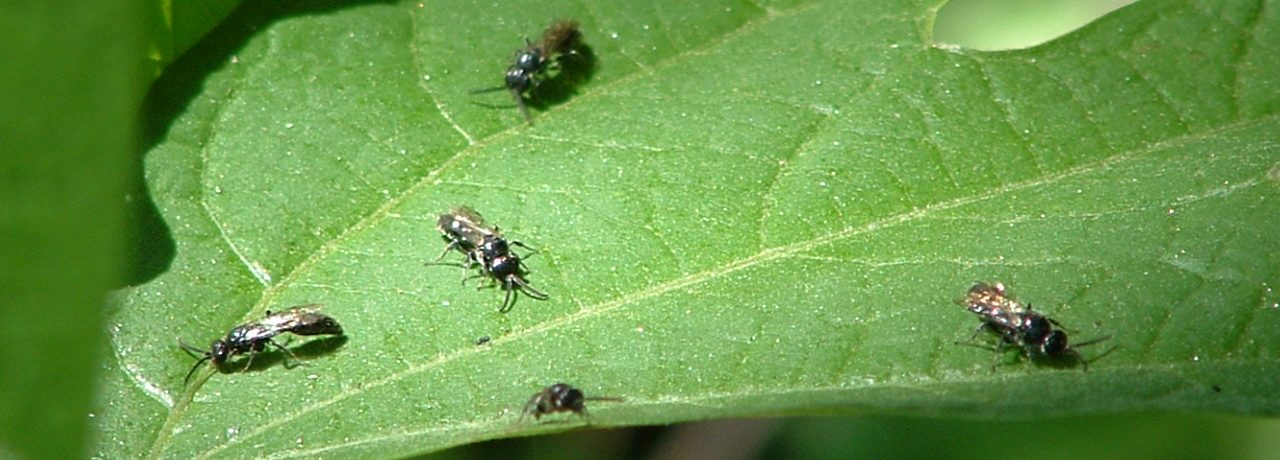
The Japanese beetle, Popillia japonica, was first detected in Riverton, NJ in 1916. Since then it has expanded its range continuing to be an important pest of ornamentals and turf. During 1920’s and early 1930’s USDA entomologists imported Tiphia vernalis Rohwer (Hymenoptera Tiphiidae) from Korea to aid in Japanese beetle control. This parasitoid also known as the spring Tiphia is a small parasitic wasp that attacks the older larvae or grubs of the Japanese beetle. With their help, populations of Japanese beetles are reduced in number from what potentially could be more severe infestations. The USDA made numerous wasp releases throughout the Northeast. Releases of T. vernalis were made between 1936 and 1949 in six of Connecticut’s eight counties. Surveys done in 2004 and 2005 confirmed that this wasp is present in every Connecticut county attacking Japanese beetle grubs. Surveys in Connecticut indicated an average of 55% parasitism of grubs sampled in mid-June. During spring look out for this beneficial insect that can aid you in dealing with the Japanese beetle.
Spring Tiphia females are about half an inch long and the males are about three-eighths of an inch long (Fig. 1). These shiny black wasps are solitary. They do not live in nests or swarms and they have only one generation per year. Male wasps emerge first and 3 to 4 days later females emerge. In Connecticut, T. vernalis adults are active from the first week of May to the beginning of June with a peak in adult numbers observed around the last week of May. Adult wasps feed on honeydew produced by insects like aphids. One can see them foraging for honeydew on the foliage of maple, cherry and their preferred tulip trees. It is possible to attract and conserve them by providing sources of nectar and this could lessen their time seeking honeydew. The extrafloral nectar from peony flower buds is very attractive and it is typically available during Tiphia adult flight.
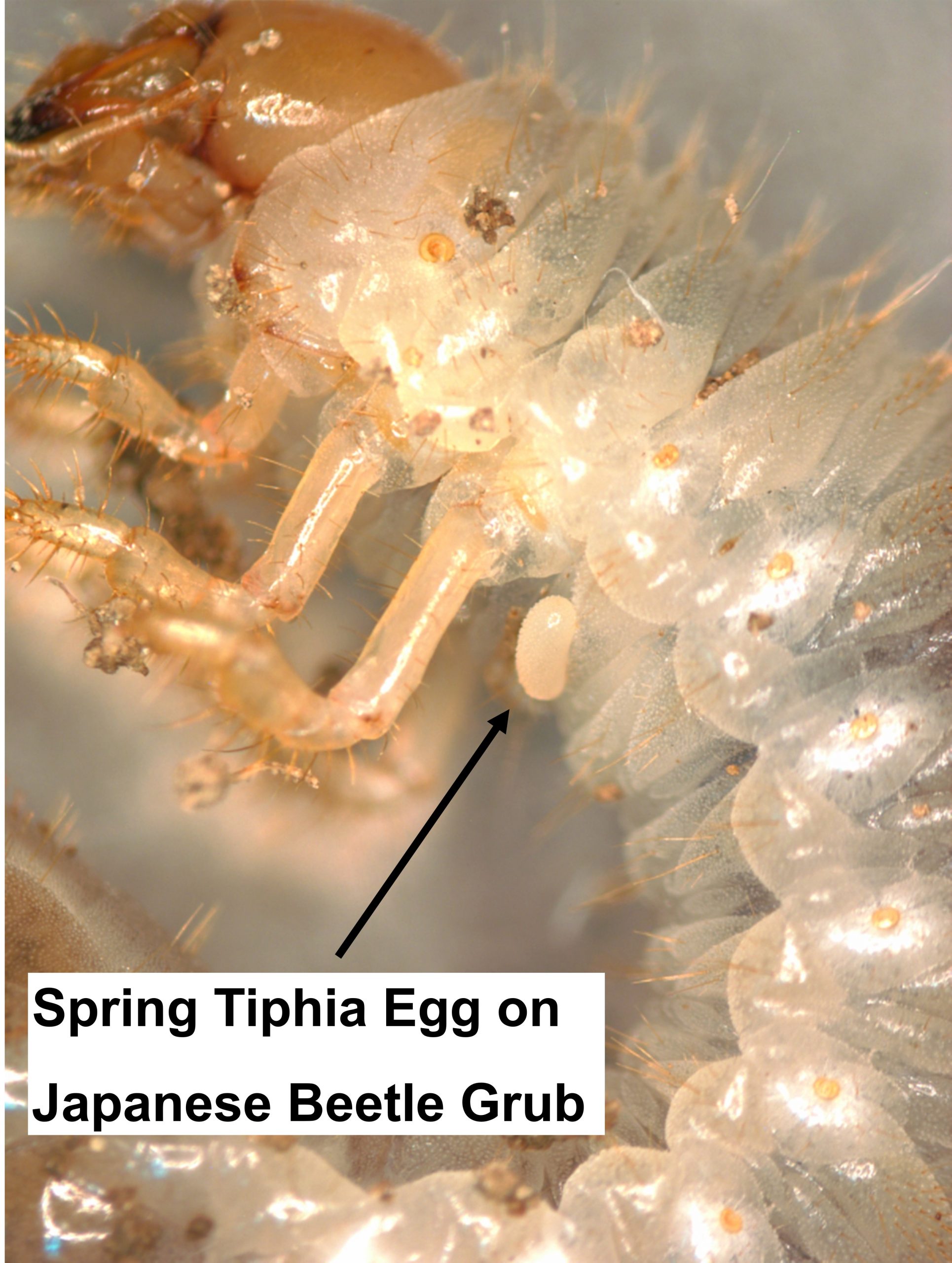
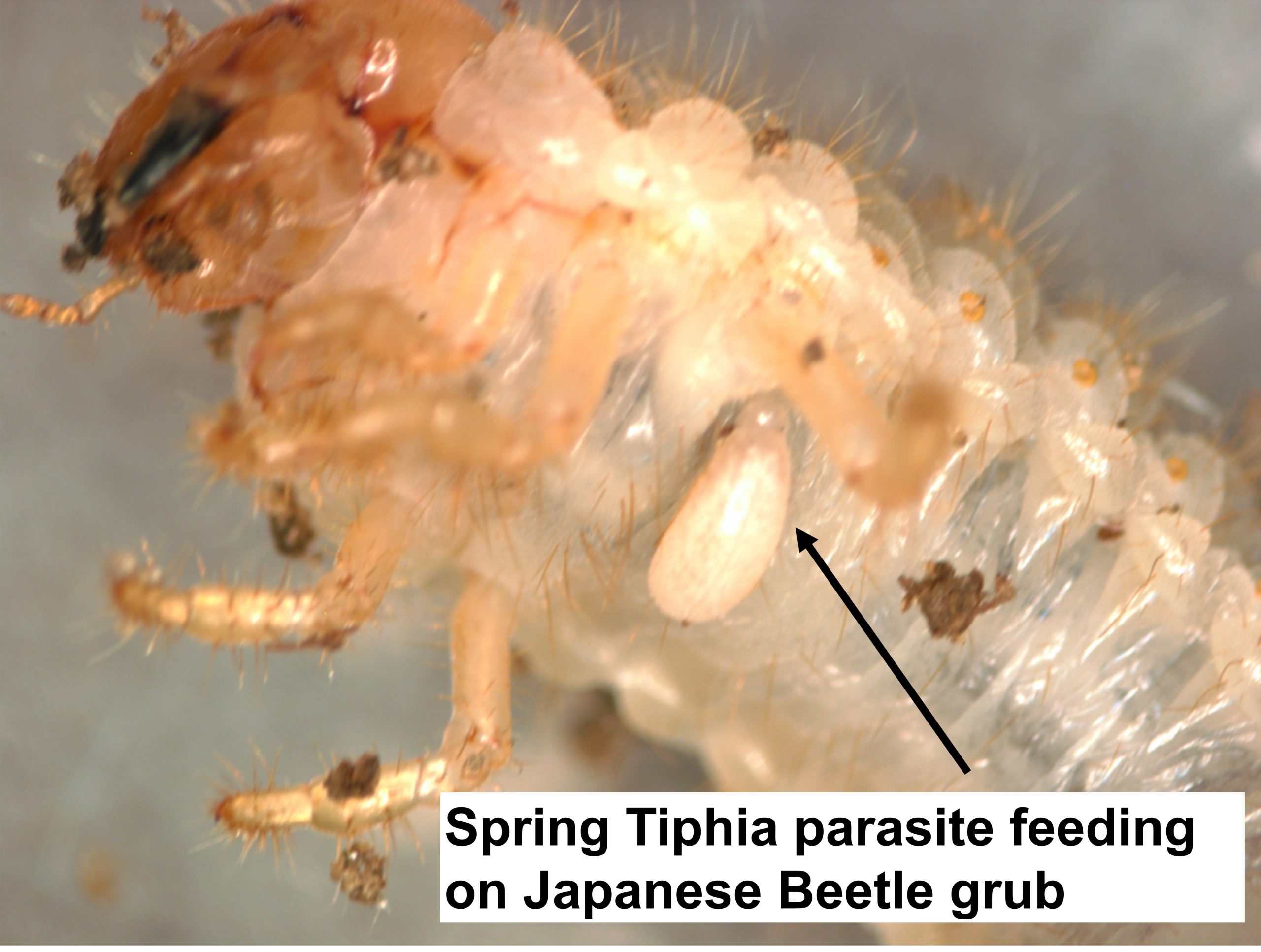
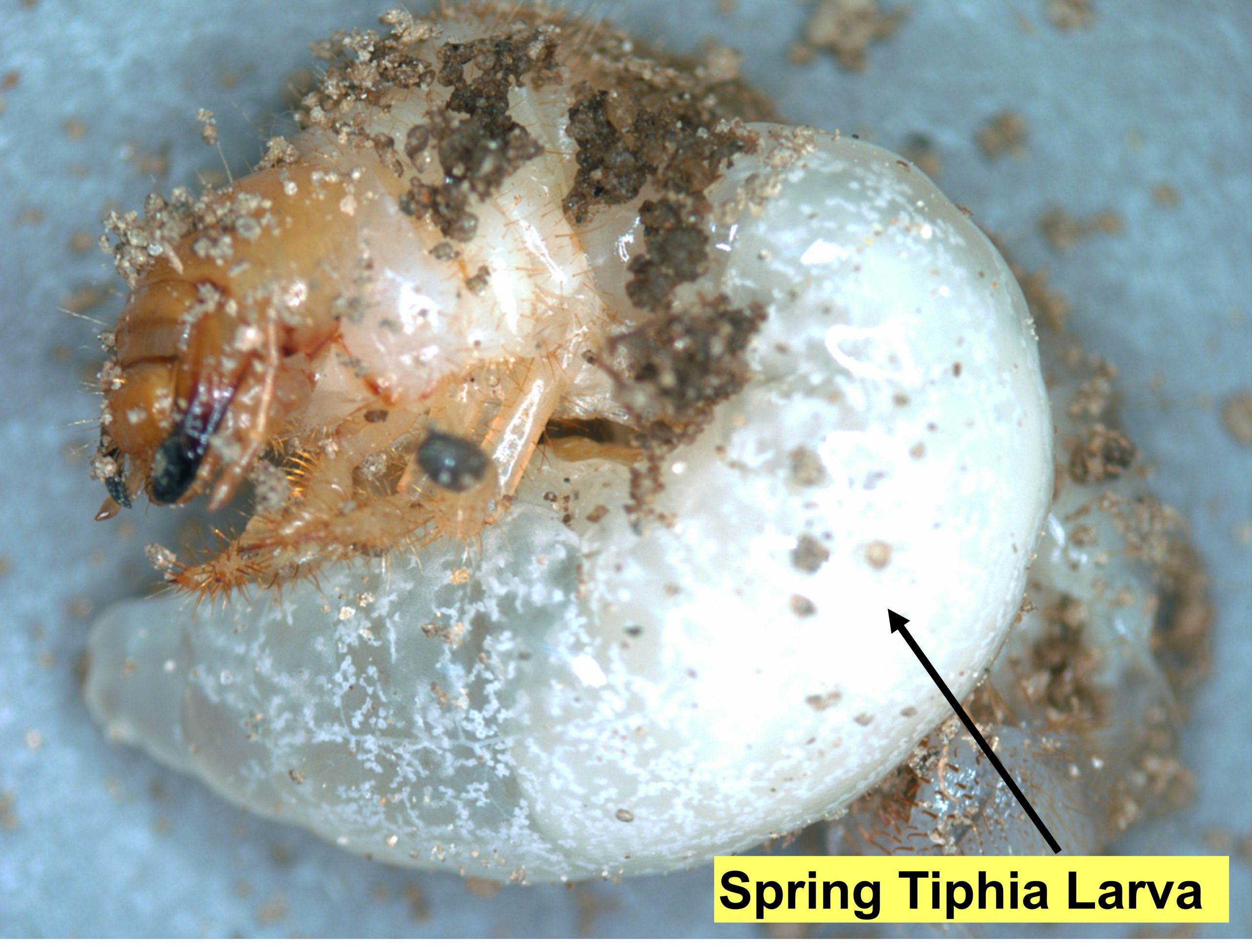

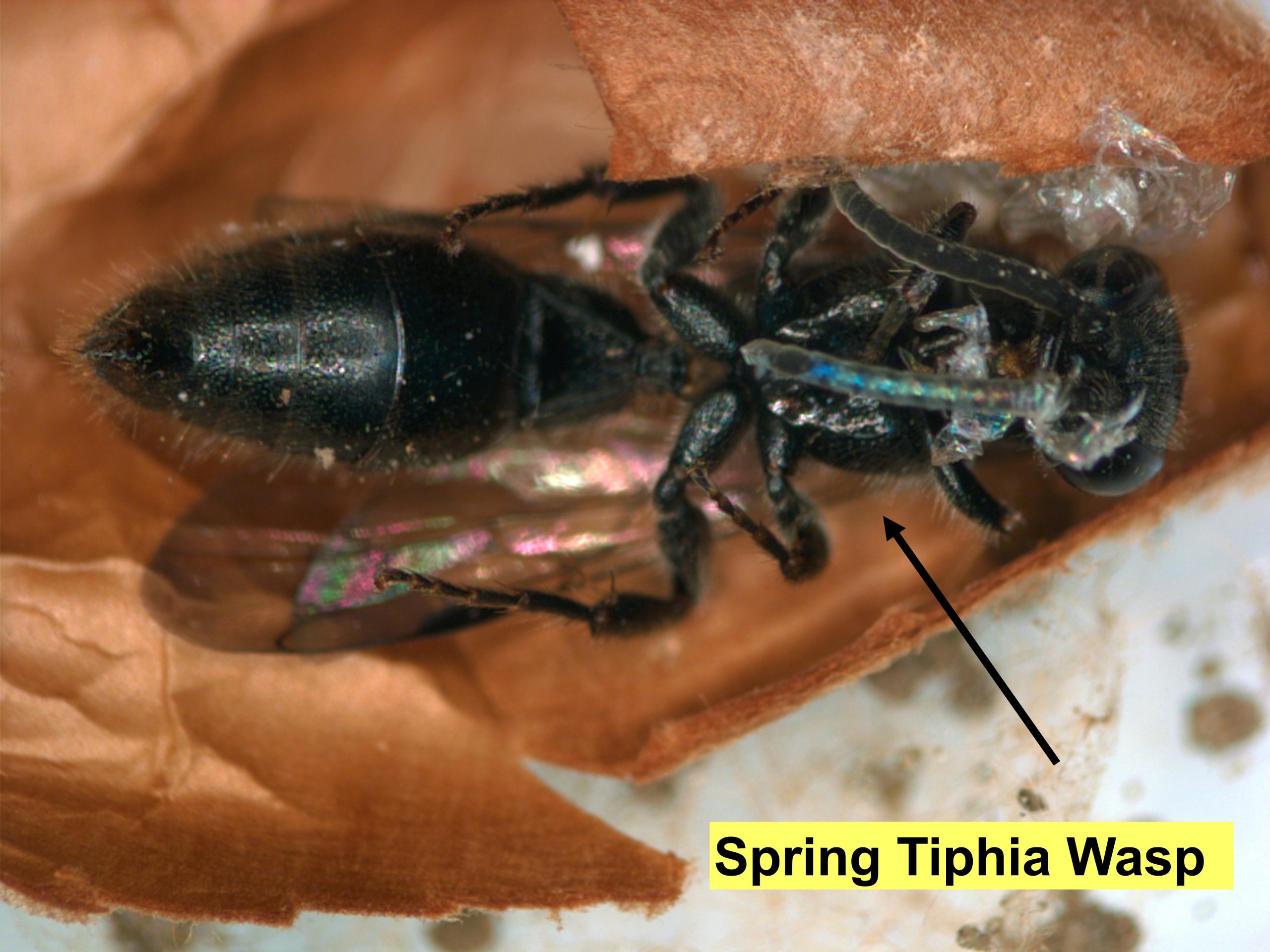
After mating, female wasps burrow into the soil and search for grubs. When a host is found, the wasp stings it and paralyzes it momentarily while the wasp attaches one egg on the ventral groove between the third thoracic and first abdominal segments (Fig. 2). The egg stage lasts for 9-10 days and the larval stage lasts about 20 days. The parasitic larva is found outside the host, securely attached and feeding on it until the host dies (Figs. 3 & 4). The Tiphia larva grows rapidly and the full-grown larva spins a papery, water resistant, silken cocoon (Fig. 5). It transforms into an adult wasp and passes the winter in this stage within the cocoon until the next spring when adults emerge to start the cycle all over again. Tiphia females live for about a month and may lay 40-50 eggs on as many different grub hosts. The female wasps seek out the fully-grown Japanese beetle grubs in the period of time when the grubs are feeding before pupation. The spring Tiphia wasp will also attack Oriental beetle grubs but to a much lesser extent reaching a maximum of 33% parasitism at various Connecticut locations.
For information regarding plants used to conserve Tiphia click here.
References
- Balock, J. 1934. The status of Tiphia vernalis Rohwer, an imported parasite of the Japanese beetle, at the close of 1933. Journal of Economic Entomology 27: 491-6.
- King, J.L. and L. B. Parker. 1950. The Spring Tiphia, an imported enemy of the Japanese beetle. USDA, Agricultural Research Administration, Bureau of Entomology and Plant Quarantine, E-799, April 1950.
- Legrand, A. 2009a. Evaluation of landscape ornamental plants as nectar plants for Tiphia vernalis and as host plants for pest scarab beetles. p. 73-76. In K. Guillard (ed), 2009 Annual Turfgrass Research Report, College of Agriculture and Natural Resources, University of Connecticut.
- Legrand, A. 2009b. Drubbing Grubs Naturally. TurfGrass Trends September 1, 2009. Pg. 49-52. http://www.turfgrasstrends.com/turfgrasstrends/Turf+maintenance/Drubbing-Grubs-Naturally/ArticleStandard/Article/detail/630612
- Ramoutar, D. and A. Legrand. 2007. Survey of Tiphia vernalis (Hymenoptera:Tiphiidae) a parasitoid wasp of Popillia japonica (Coleoptera: Scarabaeidae) in Connecticut. Florida Entomologist 90(4): 780-2.
- Reding, M. and M. Klein. 2001. Tiphia vernalis (Hymenoptera: Tiphiidae) parasitizing Oriental beetle, Anomala orientalis (Coleoptera: Scarabaeidae) in a nursery. Great Lakes Entomologist 34: 67 – 8.
Prepared by Ana Legrand
Assistant Extension Professor
Department of Plant Science
IPM Program
Reviewed by Ana Legrand, Aug. 2020.
Photos by Ana Legrand, Olena Zhivotovsky and Michelle Gelinas
The information in this document is for educational purposes only. The recommendations contained are based on the best available knowledge at the time of publication. Any reference to commercial products, trade or brand names is for information only, and no endorsement or approval is intended. UConn Extension does not guarantee or warrant the standard of any product referenced or imply approval of the product to the exclusion of others which also may be available. UConn Extension/College of Agriculture, Health and Natural Resources is an equal opportunity program provider and employer.